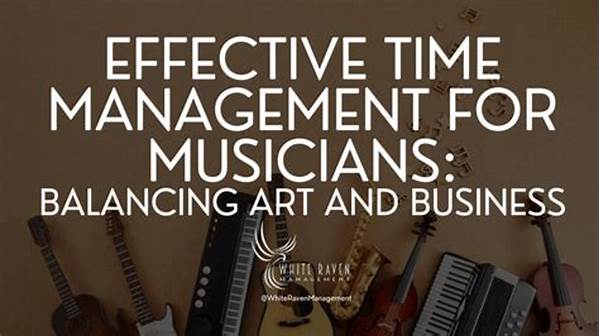In the dimly lit backstage of a bustling jazz club, Sarah sat hunched over her notebook, scribbling furiously. The club buzzed with the low hum of eager conversations, glasses clinking, and the faint fragrance of espresso wafting in the air. As a passionate saxophonist, Sarah knew the demands of her craft all too well. The world often saw the glamorous performances, but few understood the Herculean effort of balancing rehearsals, gigs, and personal time. As she jotted down her evening schedule, the question nagged at her—was her time spent honing her skill or just killing time?
Read Now : Stylish Clothing Choices For Auditions
The Essence of Prioritizing
Indeed, time management for musicians like Sarah is not just about scheduling; it’s an art form in itself. As she recounted her journey, she remembered the days spent juggling between gigs and practice sessions, her calendar filled to the brim. The art of prioritizing emerged from the chaos, each day offering a new lesson. It was like composing a new piece of music—sometimes clumsy, sometimes melodious, but always progressing.
Sarah discovered that mastering this orchestration required a careful evaluation of what truly mattered. She started by examining her itinerary, identifying rehearsals that needed more attention and gigs that could be bypassed. It wasn’t about doing it all, but doing what resonated with her musical soul. By prioritizing and planning, Sarah seamlessly integrated creativity and efficiency into her routine. This journey of transformation taught her that effective time management for musicians is a key melody in their symphonic lives.
Lessons from the Orchestra Pit
Roger, a concert pianist, shared stories of the overwhelming demands of balancing practice with life itself. Time management for musicians, he found, was like rehearsing. Only through practice and routine could he find harmony.
Emily, a cellist, reflected on her early struggles, often overwhelmed by opportunities. Her breakthrough came from the realization that not every opportunity deserved her energy. Time management for musicians taught her when to say no.
John, a violinist, discovered that downtime was as essential as practice. His best performances followed weekends spent in nature, allowing him to return rejuvenated. Time management for musicians, he learned, included rest.
Sofia, a budding composer, used to resist schedules. But, recognizing time management for musicians as vital, she created compositions that were structured yet flexible, granting her more creative freedom.
Michael, an indie band drummer, shared how multisensory learning amplified his practice. Time management for musicians wasn’t just about hours; it was about effective learning that allowed swift progress.
The Role of Discipline
Discipline became the unwritten note in Sarah’s repertoire. She recalled a seasoned mentor emphasizing, “Routine is where magic happens.” Heeding his advice, she structured her days. The morning would begin with stretches, a warm-up for both body and mind, easing her into the day. Evenings were for non-negotiable practice sessions, punctuated by short breaks to maintain focus.
Although rigid at first, this routine became as intuitive as the keys beneath her fingers. In her moments of doubt, she realized that discipline didn’t hinder her freedom; it enhanced it. The framework of time management for musicians, she found, was like the sheet music to her life—a guide, not a constraint. The more she adhered to this rhythm, the more intricate and spontaneous her improvisations became. Thus, what seemed like discipline at the outset evolved into an enabler of creativity.
Read Now : Healthy Hearing Practices For Instrumentalists
The Ebb and Flow of Time
Julian, a seasoned guitarist, embraced the ebb and flow of his artistic journey. He humorously narrated a tale of a time when he attempted an overly meticulous schedule, only to fail spectacularly. Yet, it was this failure that taught him the value of flexibility. Time management for musicians, he concluded, required room for life’s unpredictability.
(Ten insights follow here on the importance of balancing musical pursuits with personal needs, allowing rest, and ensuring adaptability in time management for musicians.)
Crafting a Harmonious Life
Sarah’s journey is mirrored in countless musicians’ lives, including Hannah, a hard-nosed percussionist battling with the complexities of her professional and personal realms. Amidst the cacophony, Hannah stumbled upon the magic of setting boundaries. Time management for musicians seemed daunting initially, yet she found solace in segmenting her life into manageable blocks.
She regaled a time when impromptu gigs nearly sabotaged cherished family dinners. As she painted vibrant strokes of her experiences, one thread became apparent—her reinvigorated appreciation for unstructured time. By dedicating certain slots solely for friends and family, Hannah discovered a newfound richness in her music. She emphasized that while the journey isn’t without detours, having a framework helps navigate its meandering paths.
The stories of these artists invite us into their world, where managing time isn’t just about efficiency but creating a life in harmony with their passion. They are reminders for every aspiring musician that beneath the glamour lies a delicate choreography of time management, awaiting its master.
The Subtle Art of Balance
Amidst stories of missed chances and near burnouts, many musicians conveyed an underlying theme of seeking balance. Like a finely tuned piano, life required adjustments to maintain its harmony. A clarinetist, Lisa, discovered that while hours augmented proficiency, they also chipped away at freshness.
Her symphonic epiphany came during a week-long retreat where clocks were absent. As days entwined with nights, Lisa’s rigid perception of time melted. What persisted was the knowledge that life, like music, bore rhythms—sometimes fast, occasionally lingering. Time management for musicians, she realized, was a flexible pact rather than a rigid contract, promising artistry without compromising life’s richness. These tales serve as both guide and muse for those tiptoeing between creativity and responsibility, reminding them to dance to the beat of their rhythm.
